透明还是地图清洗?棕榈油行业的数字地理空间可视化工具
IF 12.5
1区 管理学
Q1 BUSINESS
引用次数: 0
摘要
我们引入了 "洗图 "的概念,并询问数字地理空间可视化(DGV)工具是扭曲了信息还是提高了供应链的透明度。洗图 "解释了一种披露空间信息的过程,这种信息对目标用户几乎没有价值,而是创造、符合或扭曲了特定的叙事。在卫星技术、云端地理信息系统和复杂的网络数字编程不断进步的背景下,我们看到了提供商业活动地理空间可视化的复杂网络工具的兴起。各种农业商品公司都在投资 DGV 工具,以努力提高其运营的透明度。这些工具的功能、目标受众以及更广泛的环境和社会成果仍不明确。我们的研究基于对整个棕榈油行业采用的 DGV 工具的案头分析,以及对棕榈油和相关行业知情利益相关者的访谈。在本研究评估的 97 家公司中,我们发现有 16 家公司采用了积极的 DGV 工具。我们发现,各公司采用的地理空间可视化工具在所使用的技术、数据输入、互动程度、合作类型以及成果和利益相关者的参与程度方面各不相同。我们认为,棕榈油供应链的空间化实现了企业沟通的复杂性,而传统的企业社会责任报告则很难做到这一点。然而,我们也认为,这些工具的变革力量还有待商榷,认为 "洗地 "可能会转移人们对负面外部因素的关注。我们建议将准则和监管作为一种手段,以加强 DGV 工具对可持续发展和透明度的积极贡献。本文章由计算机程序翻译,如有差异,请以英文原文为准。
Transparency or Map‐Washing? Digital Geospatial Visualisation Tools in the Palm Oil Industry
We introduce the notion of map‐washing and ask whether digital geospatial visualisation (DGV) tools distort information or provide greater supply chain transparency. Map‐washing explains a process of disclosing spatial information that has little or no value to the intended users, but rather creates, conforms to or distorts a particular narrative. In the context of advancements in satellite technology, cloud‐based geographic information systems and sophisticated web‐based digital programming, we observe the rise of sophisticated web‐based tools that offer geospatial visualisations of business activities. Firms across a broad range of agro‐commodities are investing in DGV tools as part of efforts to achieve greater levels of transparency in their operations. The function of these tools, their intended audiences and the broader environmental and social outcomes remain unclear. Our research is based on a desk‐based analysis of DGV tools employed across the palm oil industry, and interviews with informed stakeholders in the palm oil and related industries. From 97 companies assessed in the study, we identified 16 companies with active DGV tools. We found that companies employ a spectrum of geospatial visualisation tools that differ in the technologies used, data inputs, level of interactivity, type of collaborations and the outcomes and degree of stakeholder participation. We argue that the spatialisation of palm oil supply chains achieves a sophistication in corporate communication that is more difficult to achieve with traditional CSR reporting. Yet we also contend that the transformative power of these tools is open to debate, arguing that map‐washing may deflect attention away from negative externalities. We propose guidelines and regulation as a means to enhance the positive contributions of DGV tools to sustainability and transparency.
求助全文
通过发布文献求助,成功后即可免费获取论文全文。
去求助
来源期刊

Business Strategy and The Environment
Multiple-
CiteScore
22.50
自引率
19.40%
发文量
336
期刊介绍:
Business Strategy and the Environment (BSE) is a leading academic journal focused on business strategies for improving the natural environment. It publishes peer-reviewed research on various topics such as systems and standards, environmental performance, disclosure, eco-innovation, corporate environmental management tools, organizations and management, supply chains, circular economy, governance, green finance, industry sectors, and responses to climate change and other contemporary environmental issues. The journal aims to provide original contributions that enhance the understanding of sustainability in business. Its target audience includes academics, practitioners, business managers, and consultants. However, BSE does not accept papers on corporate social responsibility (CSR), as this topic is covered by its sibling journal Corporate Social Responsibility and Environmental Management. The journal is indexed in several databases and collections such as ABI/INFORM Collection, Agricultural & Environmental Science Database, BIOBASE, Emerald Management Reviews, GeoArchive, Environment Index, GEOBASE, INSPEC, Technology Collection, and Web of Science.
 求助内容:
求助内容: 应助结果提醒方式:
应助结果提醒方式:


